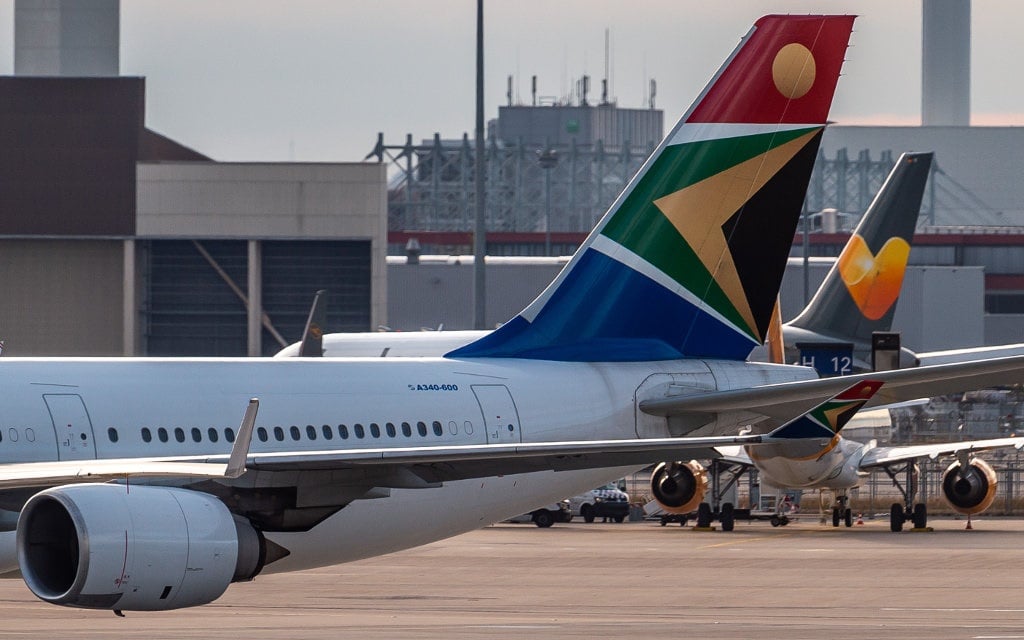


A South African Airways aircraft on the apron of Frankfurt Airport in 2018.
Silas Stein/picture alliance via Getty Images
- If all goes according to plan, all SAA’s leased aircraft would have been returned to lessors by the end of July.
- The planes the airline has kept, seem to be the least efficient and most costly ones to operate of what SAA had in its fleet.
- Returning all leased aircraft seems to be out of step with the trend among airlines globally at the moment, says an expert.
This week four more planes leased by South African Airways – two A320s and two A330-300s – were returned to lessors.
This is in line with the business rescue practitioners’ aim to have all agreements the state-owned airline had or has for the lease of planes terminated by the end of July.
A number of aircraft actually owned by the state-owned airline are still up for sale since January. These include five A340-300s and four A340-600s – used for long haul flights.
By mid-June, the practitioners had already returned 17 aircraft to lessors. As Fin24 reported at the time that this was because the lessors had elected to initiate the termination of the leases, according to the rescue practitioners.
By having the planes returned to them, the lessors have the assets back under their control. The Cape Town Convention, signed in 2006, aimed to facilitate asset-based financing and leasing of aviation equipment by reducing a creditor’s risk and increasing legal predictability in these kinds of transactions, including if a debtor goes insolvent or default. Although South Africa was among the countries who signed the treaty, it has never ratified it.
The aircraft returned by mid-June included four A319s; three A340-300s; three A340-600s; five A330-200s and two B737s.
Three A319s and one A330-300 are being stored in South Africa. In terms of the rescue plan, the airline will require six aircraft when restarting operations.
Middle men again?
According to an aviation expert, who wants to remain anonymous, given the current state of the airline industry it seems that airlines in general have been able to renegotiate deep discounts on their leases for aircraft, therefore, opting not to return all their leased aircraft.
“Redelivering leased aircraft and taking delivery of new aircraft is an expensive and laborious process, especially if you consider that SAA took delivery of Airbus A350 aircraft less than a year ago. Are these aircraft no longer fit for purpose a few months later?” asks the expert.
In his view, no “sensible” aircraft lessor will transact with SAA without a government guarantee in future after their experience in the business rescue process.
“This begs the question about what is waiting for SAA in terms of new aircraft purchases and leases when it restarts, and, especially given the airline’s history, whether there will be the use of middle men again,” he says.
What is left?
According to Linden Birns, managing director of Plane Talking, it is interesting to look at the aircraft SAA is left with. They seem to be the least efficient and most costly ones to operate of what the airline had in its fleet.
He also points out that the planes up for sale were already advertised in January. Those planes, even though the fuel price has come down, are still relatively expensive to operate compared to others they had.
As for the chances of obtaining buyers for these A340s, Birns expects their residual value to actually be “rock bottom”.
“The market for those aircraft has dried up. SAA’s best option would be to have them dismantled and to sell off their engines and other valuable components,” says Birns.
Birns points out that it is, as yet unclear if or when SAA will restart flights. It would not be ideal to restart long haul flights with the A340s, but it would be possible. The airline would, however, have to ensure that its pilots, crew and technicians retain the relevant competencies required.
He wonders whether, if the airline does decide to restart long haul aircraft, it will source other aircraft, and depending on what they opt for, it could become very expensive.
As for the A319s, he says these could be used on domestic flights and were manufactured to SAA specifications.
SAA’s low-cost subsidiary Mango as started domestic flights since business travel were allowed in June.
SAA was placed in business rescue after a series of turnaround attempts that resulted in more than R30 billion in government bailouts being poured into the airline over a decade, failed.
In mid-April the rescue practitioners informed creditors that the DPE denied a request to fund the business rescue by R7.7 billion.
The rescue plan accepted by creditors since then, requires about R10.3 billion in new funding. The most pressing is R2.2 billion for voluntary severance and retrenchment packages, R2 billion for working capital and about R800 million for post-commencement creditors.
Although both Minister of Finance Tito Mboweni as well as Minister of Public Enterprises Pravin Gordhan have indicated their commitment to “mobilise” the funding, it is as yet unclear what the source thereof will be.
The business rescue practitioners of South African Airways have called a creditors’ meeting for Friday 24 July.

